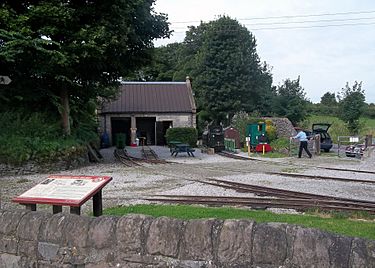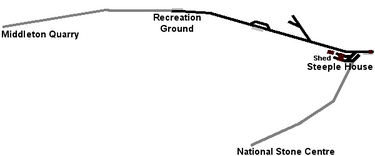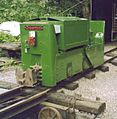Steeple Grange Light Railway facts for kids
Quick facts for kids Steeple Grange Light Railway |
|
|---|---|
 |
|
| Locale | Wirksworth, Derbyshire, England |
| Terminus | Steeple Grange |
| Coordinates | 53°05′44″N 1°34′15″W / 53.0956°N 1.5709°W |
 |
|
| Commercial operations | |
| Original gauge | 4 ft 8 1⁄2 in (1,435 mm) standard gauge |
| Preserved operations | |
| Length | 1⁄2 mile (0.80 km) |
| Preserved gauge | 18 in (457 mm) |
| 1985 | opened |
The Steeple Grange Light Railway is a special train line in Wirksworth, Derbyshire, UK. It's a "heritage railway," which means it keeps old trains and tracks working for people to enjoy. This railway uses cool industrial trains and wagons. These trains used to work in old mines, quarries, and steel factories across the country.
Contents
Exploring the Steeple Grange Railway Line
The Steeple Grange Light Railway is about 1⁄2-mile (0.8 km) long. It's an 18 in (457 mm) "narrow gauge" line. This means its tracks are closer together than regular train tracks. The railway was built in 1985. It follows an old path that was once part of the Killer's Branch line. This line used to connect Steeple House Junction to Middleton Quarry.
The railway has a steep hill called an "incline." It goes up at a 1:27 slope. This means for every 27 feet you go forward, you go up 1 foot. This incline leads from the engine shed to Middleton Top station. You can find a path from there to the road. There's also a building called a carriage shed at Dark Lane. This is where the railway keeps its passenger wagons and some trains that are being fixed.
Future Plans for the Railway
The railway has exciting plans to make the line even longer!
- The National Stone Centre wants the railway to build a line to their place. This would connect the railway to the Ecclesbourne Valley Railway.
- The railway also hopes to make the steep incline longer. It would go all the way to the level crossing near Middleton Quarry.
The railway has already made some of its dreams come true! They extended the line from Recreation Ground station. It now goes towards Lawson's Loop. This is a special track where trains can switch lines. They reached Middleton station in 2019. Trains now run there regularly. At Middleton station, there's a "ballast chute." This is a slide used to pour small stones (ballast) from wheelbarrows into a special wagon called Lenard. When a train crosses the road at the level crossing, a guard helps. They use flags to warn cars and make sure the train can pass safely.
Meet the Locomotives of SGLR
The Steeple Grange Light Railway has several cool trains, called locomotives. Two of them are used to carry passengers. Others are used for track work. Many more are being fixed up to run again!
Greenbat: The Main Battery Train
The railway's most important train is Greenbat. It's a 1.5 long tons (1.52 t; 1.68 short tons) battery-powered train. This means it runs on electricity stored in big batteries. It was built by a company called Greenwood and Batley in Leeds. Greenbat is a "trammer" type locomotive. It has a special cab that can fold down. This was designed so it could fit into small mine shafts. However, Greenbat was ordered by a steel factory. They asked for the cab to be fixed in place. So, Greenbat has never actually been underground. It worked in different steel factories instead.
A person named Adrian Booth saved Greenbat. He gave it to the Steeple Grange Light Railway when the line was just starting. Greenbat was given air brakes. For almost 15 years, it worked hard, often pulling a special wagon for people who worked in mines. In 2005, it got new batteries. The old ones had lasted 15 years, even though they were only expected to last 10! Greenbat is the main train used for regular trips, private parties, and special Santa train rides in December.
- Power: 1 electric motor
- Voltage: 48 V from lead acid batteries
ZM32 Horwich: The Unique Diesel Train
ZM32 Horwich was built in 1957. This train is very special because it's the only 18 in (457 mm) gauge Ruston and Hornsby LAT train still around! It was bought by British Railways to work at their Horwich workshops. Later, it was saved and kept at the National Railway Museum. When it was sold, it was almost sent to a banana farm in South America! But it ended up waiting in Liverpool docks until it was bought for the Gloddfa Ganol Museum in Wales. There, its tracks were changed to 2 ft (610 mm) wide, and it was fixed up to run.
When the Gloddfa Ganol Museum closed, a member of the Steeple Grange Light Railway bought Horwich. They changed its tracks back to 18 in wide. They also added air brakes. After a problem with its gearbox, Horwich was fully repaired. Now it's back on the line, painted in a green color. It's used along with Greenbat. People recently voted Horwich as the most popular non-steam narrow gauge train!
This train is often used to help Greenbat on the steep hill. It helps pull the Santa trains up to Santa's Grotto in December.
- Engine: Ruston and Hornsby 20 hp (15 kW) diesel engine
- Transmission: Hydraulic system with 2 gear boxes
Hudson: The Home-Built Train
This train, called Hudson, is quite unusual because it was built at home! The Steeple Grange Light Railway started with trains and tracks from Ladywash Mine. The only train from there, No.6, was in very bad shape. Before Greenbat arrived, someone decided to turn one of the Ladywash Hudson wagons into a train. Alwyn Ambrey did this in 1988. He used an engine and parts from a cricket pitch roller. The train could carry two passengers and the driver.
At first, the engine wasn't strong enough for the steep hill. It also wasn't in good condition, so it wasn't used much. In 2003, J Scott fixed up the engine. This helped a lot with the power problem. He also added much better brakes. Two years later, a new engine was found. It was similar to the old one but had a special gearbox. This made the train much better at pulling things. However, Hudson is not used regularly. It still doesn't have enough power to climb the steep hill to Middleton station.
- Engine: 3½ HP Villiers Mk25 with a reduction gearbox
- Transmission: Special clutch and chain drive
Claytons: The Workhorse Battery Trains
The railway has three battery-powered trains called Claytons. They are owned by private individuals. L10 and L16 (named Peggy) are smaller trains. They weigh about 1+3⁄4 long tons (1.8 t; 2.0 short tons) and have 7 hp (5.2 kW). They were bought directly from industrial use. Peggy has recently been fixed up and is now running. It uses the old batteries from Greenbat. Peggy has a special controller for speed. Peggy is the main train for work on the railway. It takes volunteers up and down the line to fix tracks and other parts. You often see it moving the tool wagon. Peggy also works on the branch line that goes into the quarry.
Lady Margorie is another small Clayton train. It also has 7 hp (5.2 kW) and weighs 1+3⁄4 long tons (1.8 t; 2.0 short tons). It was designed to work in small spaces, like 4 ft (1.22 m) wide sewer pipes! It even has a special roof shape to fit in tight spots. It uses a modern electronic controller. On May 20, 2012, Lady Margorie was renamed Peter. This was in honor of Peter Sellers, who used to be the chairman of the railway society.
Ladywash Mine No.6: The First Train
This train, No.6, was the very first locomotive at the Steeple Grange Light Railway. It came with a lot of tracks and wagons from Ladywash Mine in Derbyshire. It's a 10 hp (7.5 kW), 3 long tons (3.05 t; 3.36 short tons) train, also made by Greenwood and Batley.
No.6 worked its whole life at Ladywash Mine. It had some interesting changes made to it over time. A picture of it working at the mine looks very different from how it looks now! It also had a special electronic controller, but that was removed before it was sold.
When No.6 arrived at the Steeple Grange Light Railway, it was in bad shape. It also didn't have its controller. So, it was left in different sidings and not touched for a while. Finally, in 2004, someone bought it, and work began to fix it up. Its frame has been repainted, and its axleboxes (parts that hold the wheels) have been repaired. Now it's back at the railway. It's currently a rolling chassis, meaning it has wheels but no engine yet. New parts are being made for it. Work is also happening to build a new controller. In the future, its two motors will be fixed, and its gearboxes will be checked. Then, it will be rewired and put back together.
- Motors: 2 electric motors
- Batteries: 60V lead-acid batteries
- Weight: 3 tons when new, 3¼–3½ tons with changes
Images for kids



